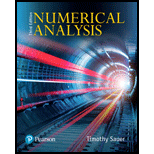
Concept explainers
Find the jacobian of the functions
a.
b.
c.
d.
a.
To find: The Jacobian of the function.
Answer to Problem 1E
TheJacobian of the function is
Explanation of Solution
Given information:
The given function is,
Concept used:
The Jacobian of the function is calculated as,
The given function is,
The Jacobian of the function is calculated as,
Substitute
Therefore, the Jacobian of the functionis
b.
To find: The Jacobian of the function.
Answer to Problem 1E
The Jacobian of the function is
Explanation of Solution
Given information:
The given function is,
Concept used:
The Jacobian of the function is calculated as,
The given function is,
The Jacobian of the function is calculated as,
Substitute
Therefore, the Jacobian of the function is
c.
To find: The Jacobian of the function.
Answer to Problem 1E
The Jacobian of the function is
Explanation of Solution
Given information:
The given function is,
Concept used:
The Jacobian of the function is calculated as,
The given function is,
The Jacobian of the function is calculated as,
Substitute
Therefore, the Jacobian of the function is
d.
To find: The Jacobian of the function.
Answer to Problem 1E
The Jacobian of the function is
Explanation of Solution
Given information:
The given function is,
Concept used:
The Jacobian of the function is calculated as,
The given function is,
The functions are,
The Jacobian of the function is calculated as,
Substitute
Therefore, the Jacobian of the function is
Want to see more full solutions like this?
Chapter 2 Solutions
Numerical Analysis
Additional Math Textbook Solutions
Pathways To Math Literacy (looseleaf)
Precalculus: A Unit Circle Approach (3rd Edition)
College Algebra (Collegiate Math)
Elementary Statistics
Precalculus
Elementary Statistics (13th Edition)
- What can you conclude about a complex-valued function f(z) that satisfies 1. f is complex differentiable everywhere 2. ƒ(z+1) = ƒ(z) for all z 3. For a fixed complex number a with nonzero imaginary part, f(z+a) = f(z) for all z ? Justify your answer. (Hint: Use Liouville's theorem.)arrow_forward6. Solve the system of differential equations using Laplace Transforms: x(t) = 3x₁ (t) + 4x2(t) x(t) = -4x₁(t) + 3x2(t) x₁(0) = 1,x2(0) = 0arrow_forward3. Determine the Laplace Transform for the following functions. Show all of your work: 1-t, 0 ≤t<3 a. e(t) = t2, 3≤t<5 4, t≥ 5 b. f(t) = f(tt)e-3(-) cos 4τ drarrow_forward
- 4. Find the inverse Laplace Transform Show all of your work: a. F(s) = = 2s-3 (s²-10s+61)(5-3) se-2s b. G(s) = (s+2)²arrow_forward1. Consider the differential equation, show all of your work: dy =(y2)(y+1) dx a. Determine the equilibrium solutions for the differential equation. b. Where is the differential equation increasing or decreasing? c. Where are the changes in concavity? d. Suppose that y(0)=0, what is the value of y as t goes to infinity?arrow_forward2. Suppose a LC circuit has the following differential equation: q'+4q=6etcos 4t, q(0) = 1 a. Find the function for q(t), use any method that we have studied in the course. b. What is the transient and the steady-state of the circuit?arrow_forward
- 5. Use variation of parameters to find the general solution to the differential equation: y" - 6y' + 9y=e3x Inxarrow_forwardLet the region R be the area enclosed by the function f(x) = ln (x) + 2 and g(x) = x. Write an integral in terms of x and also an integral in terms of y that would represent the area of the region R. If necessary, round limit values to the nearest thousandth. 5 4 3 2 1 y x 1 2 3 4arrow_forwardCape Fear Community Colle X ALEKS ALEKS - Dorothy Smith - Sec X www-awu.aleks.com/alekscgi/x/Isl.exe/10_u-IgNslkr7j8P3jH-IQ1w4xc5zw7yX8A9Q43nt5P1XWJWARE... Section 7.1,7.2,7.3 HW 三 Question 21 of 28 (1 point) | Question Attempt: 5 of Unlimited The proportion of phones that have more than 47 apps is 0.8783 Part: 1 / 2 Part 2 of 2 (b) Find the 70th The 70th percentile of the number of apps. Round the answer to two decimal places. percentile of the number of apps is Try again Skip Part Recheck Save 2025 Mcarrow_forward
- Algebra & Trigonometry with Analytic GeometryAlgebraISBN:9781133382119Author:SwokowskiPublisher:Cengage
 College Algebra (MindTap Course List)AlgebraISBN:9781305652231Author:R. David Gustafson, Jeff HughesPublisher:Cengage Learning
College Algebra (MindTap Course List)AlgebraISBN:9781305652231Author:R. David Gustafson, Jeff HughesPublisher:Cengage Learning Elements Of Modern AlgebraAlgebraISBN:9781285463230Author:Gilbert, Linda, JimmiePublisher:Cengage Learning,
Elements Of Modern AlgebraAlgebraISBN:9781285463230Author:Gilbert, Linda, JimmiePublisher:Cengage Learning,


